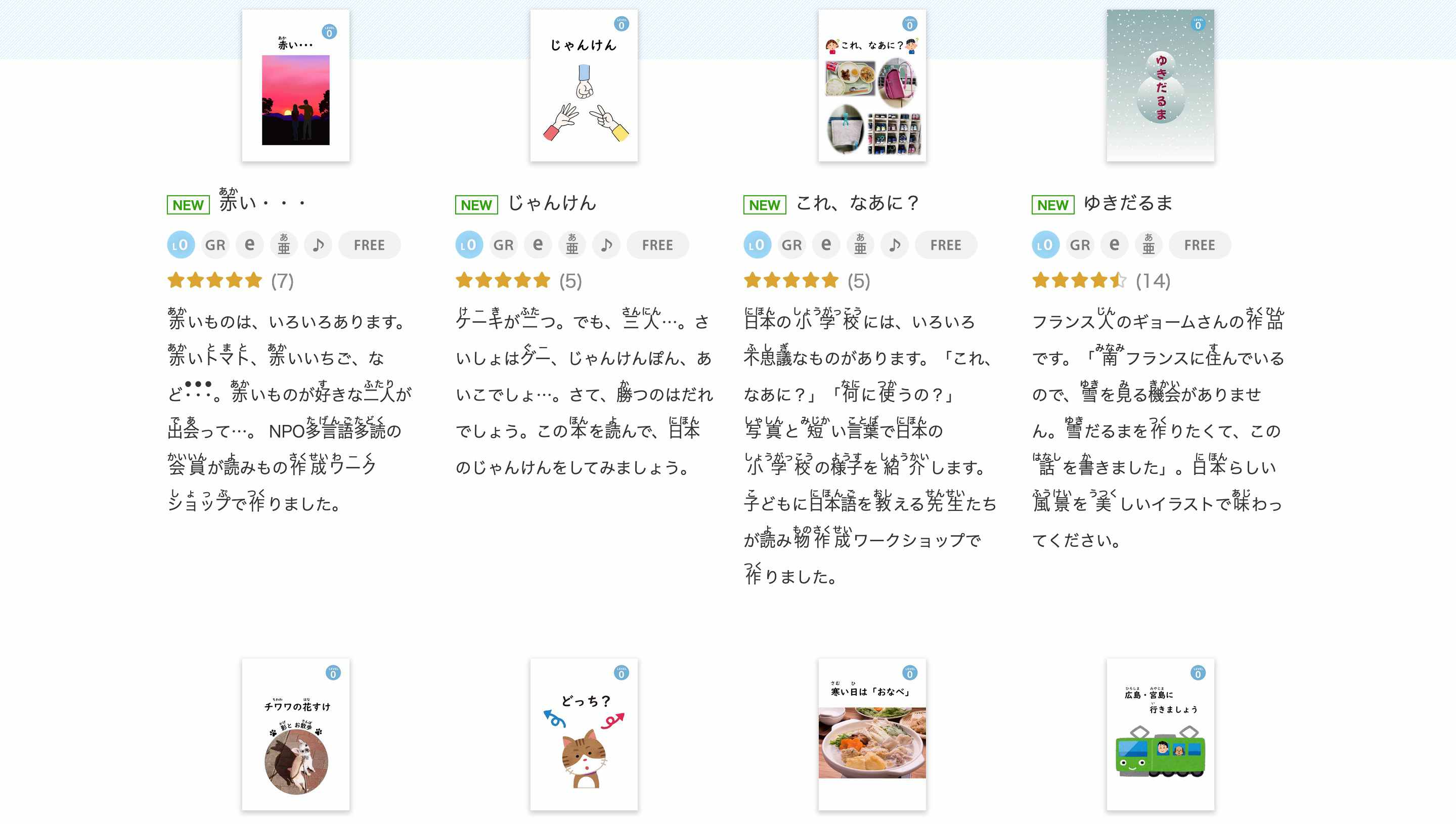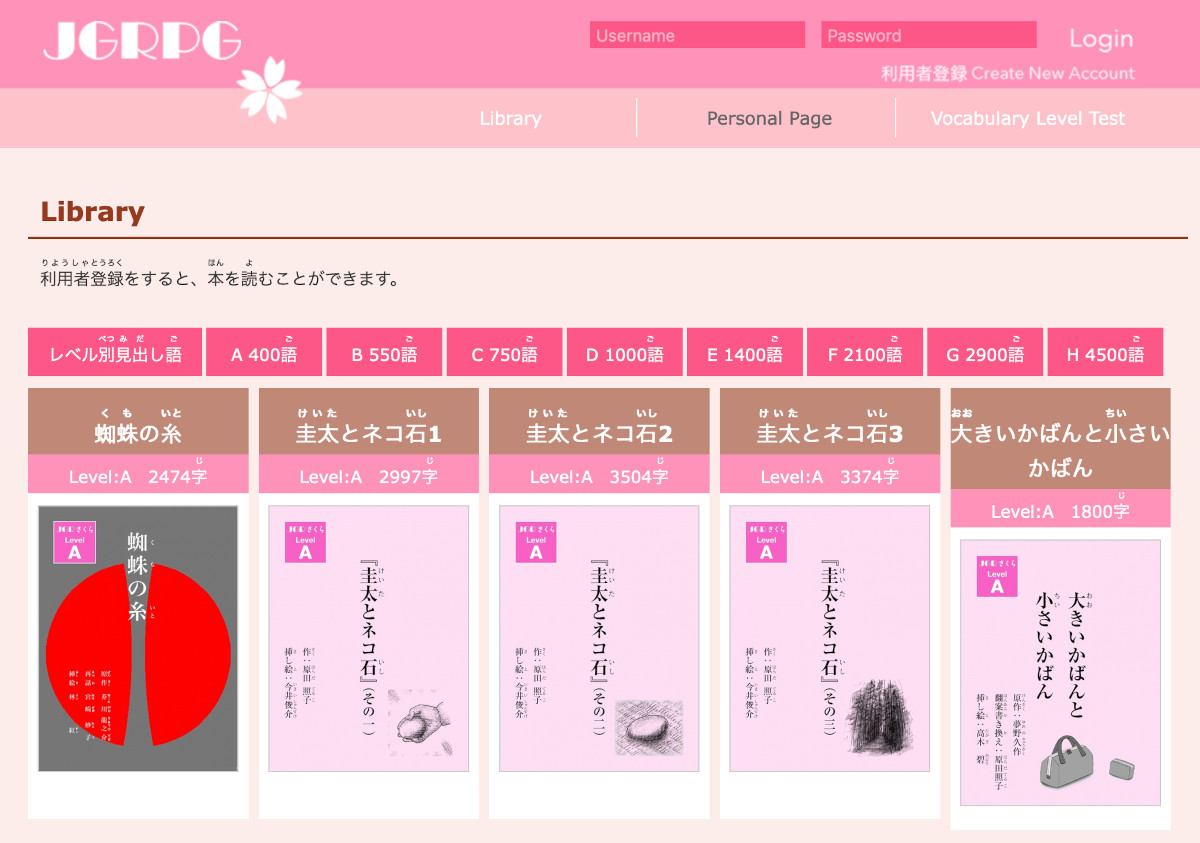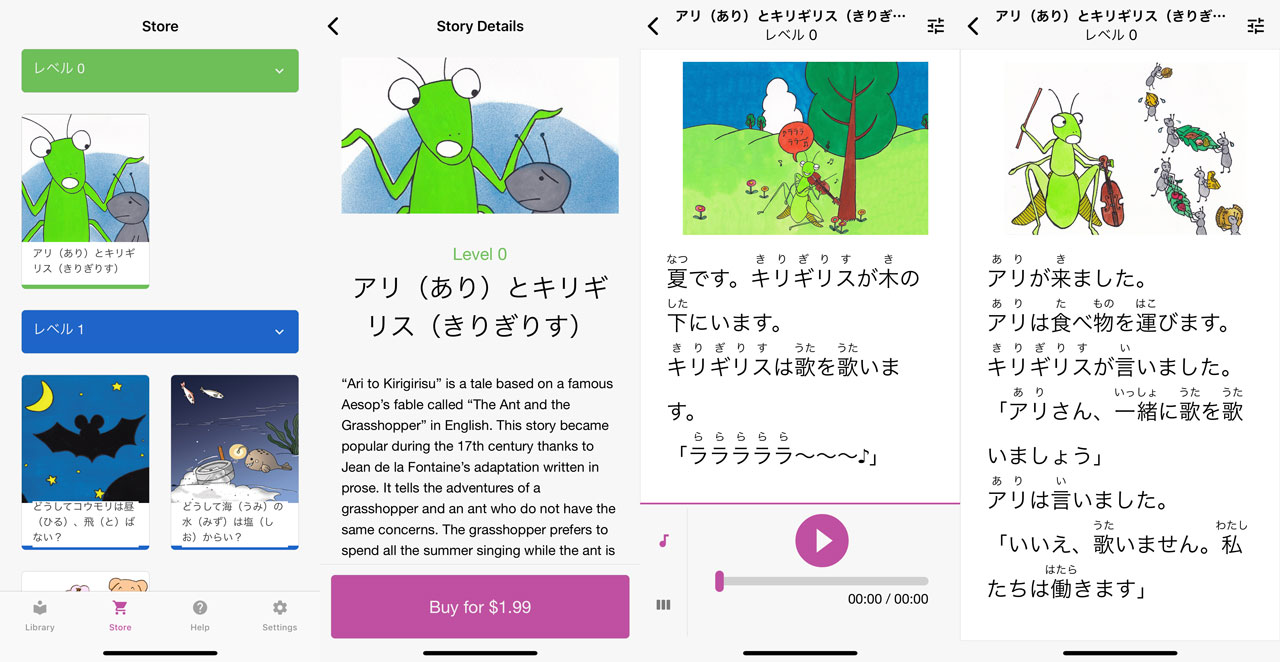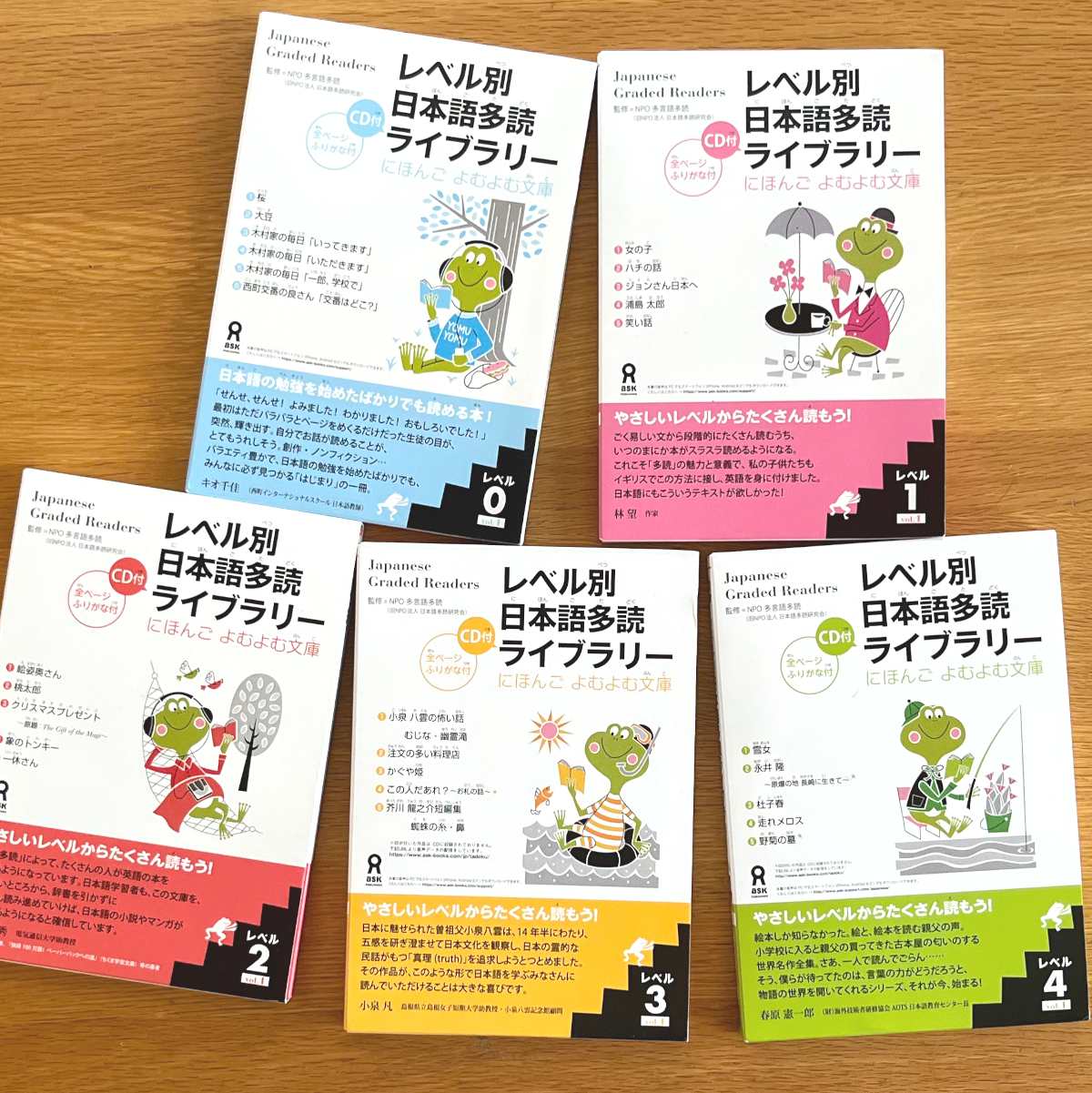One of the best ways to level up your Japanese is by reading — as much as possible! In the best case scenario, you should try to choose something interesting to you that you can read smoothly, without having to take breaks or look things up. This is a process known as extensive reading. Even so, this can be easier said than done. Learners might be used to the style and length of texts from their textbooks but feel completely overwhelmed by longer books. Or perhaps a learner has decided to pick up their first book in Japanese, only to be discouraged when they realize that it's beyond their current ability level. Finding books that are simple enough to understand, but interesting enough to compel you to read can be difficult for Japanese learners, especially those in the beginner stage.
Not only is this an enjoyable, confidence-building activity, but it'll make your Japanese a lot better too!
Thankfully, this is where graded readers come in! Graded readers are book series that feature a variety of stories sorted into different levels of difficulty, or "grades." For Japanese, this usually is determined by the vocabulary and grammar used, often corresponding to the 5 levels of the Japanese Language Proficiency Test (JLPT), but different publishers and organizations have different levels and definitions. Graded readers offer everyone, even Japanese beginners, fun stories to read. Not only is this an enjoyable, confidence-building activity, but it'll make your Japanese a lot better too!
So, ready to dive in? Great! In this article, I will talk more about what graded readers are and how to get the most out of them. My co-author Emily and I have also taken a look at some of the options available so we can recommend the best graded readers for you, regardless of whether you prefer to use digital books or physical ones, free libraries or paid collections, or even an app.
- What is a Graded Reader?
- Extensive Reading: How to Get the Most out of Graded Readers
- Our Recommendations
- What's Next?
What is a Graded Reader?
As mentioned earlier, graded readers are collections of different stories designed for language learners, sorted into categories based on difficulty. Usually, these books start at the beginner level and increase in difficulty. Additionally, just because these books are designed for beginner readers doesn't mean they're books for kids. In fact, since many of the companies that produce graded readers promote extensive reading, they aim to publish a range of different stories that appeal to learners regardless of age and interests. Some graded readers are simplified versions of well-known stories too. Ideally, there's something that piques your interest in every collection.
Many of the companies that produce graded readers aim to publish a range of different stories that appeal to learners regardless of age and interests.
While graded readers have become more popular for language learners in many languages, they're still relatively new in Japanese, so unfortunately there are fewer options available than you can find in English or Spanish, for example. That said, there are a couple of great options we think will fit the bill for any Japanese student looking to learn to read and improve their overall language ability.
Another point I want to make is that graded readers are simply a stepping stone on your Japanese learning journey, not the destination. What I mean by that is that I think graded readers are for a Japanese learner at a specific stage in their Japanese learning progress — before starting to dive into native materials. I think they should help you bridge the gap between being a learner who has yet to start reading in Japanese, and someone who reads native materials as part of their studying.
Extensive Reading: How to Get the Most out of Graded Readers
I've mentioned it a few times before, but let's talk a bit more about what extensive reading is, as doing so will give us an idea of how best to use graded readers for studying. Extensive reading is a language-learning strategy where learners practice by reading longer, simpler texts, as smoothly as possible without stopping to look up unfamiliar vocabulary or grammar.
NPO Tadoku Supporters, a pioneering organization for extensive reading for Japanese learners, has some recommendations on their website for extensive reading. They suggest:
- Reading easy books that you don't need to try and translate (i.e., it's best to not push yourself with materials that are too difficult for your current level).
- Don't use a dictionary or look up words you don't know. Instead, it's best to try and figure out the meaning from context or the pictures that go with the story, if there are any. Otherwise:
- Skip over words, phrases, and passages that are too difficult. It's better to skip things to keep your momentum up rather than getting stuck on one little part.
- Finally, don't be afraid to stop reading a book that's too difficult or uninteresting and find something you like better.
Your aim should not be to translate a book into English as you read, but rather to comprehend the story as it is in Japanese.
Keeping all this in mind can help you understand what makes a graded reader set good. It should have a wide range of books, across a number of different skill levels, so that you can find something that's not only suitable for your abilities, but pertains to your interests as well. And remember, your aim should not be to translate a book into English as you read, but rather to comprehend the story as it is in Japanese. This might be a little difficult to grasp for absolute beginners, but as you learn more of the language you'll encounter concepts that you can understand or express better in Japanese than in English, and you'll find your thoughts moving straight from the Japanese text to understanding, without having to make a detour into English.
Finally, while I think it can be great to push yourself to complete something you're interested in, and really gratifying once you finish it, if you want to follow these guidelines then reading shouldn't be an extremely taxing activity for you. Instead, it's best to read things that are suited to your level, that allow you to relax and read comfortably without feeling the urge to look up every other word.
Our Recommendations
In this article, I wanted to focus on books that were meant for language learners rather than native speakers, had a series of different grades or difficulty levels available, and were written entirely in Japanese. That means the list of recommendations won't include materials that offer English translations. While having the English translation can certainly help comprehension, it reinforces translation rather than natural comprehension.
With aallllll that out of the way, let's get to reading!
TADOKU Supporters (Free Books) / にほんごたどく (無料の読み物)
During my hunt for graded readers, I found two great free libraries of graded readers online. In my opinion, these two libraries should really be all you need. The first is a collection of free materials available on the Tadoku Supporters' website.

NPO Tadoku Supporters is a non-profit organization (that's the "NPO" part) that has not only helped establish the use of graded readers and extensive reading in Japanese, but has also become a major player in this space, advising other similar organizations and creating graded readers for a variety of publishers. In fact, many of the most popular graded reader sets, like the ones from Ask Publishing and Taishukan, as well as the White Rabbit Press App, consist of stories from NPO Tadoku Supporters. Of course, they produce books under their own name as well, a large library of which is available for free on their website.
NPO Tadoku Supporters also hosts events, courses, and lessons such as an online reading group, and you can attend some of them for free. NPO Tadoku Supporters has their own criteria for grading books, from Level 0, called "starter," up to Level 5, called "Upper-Intermediate or Above." The levels range from the absolute beginners up to books designed for JLPT N2 and N1 learners. You can see more about their criteria on their website here.
Among the free library on their website, they have books in all 5 levels, though the most for Level 0 and Level 3, and only a single book for Level 5. All the books in their library are graded readers with e-books available, and feature furigana except for the couple of books that are in kana only. Each book is presented with a user rating and icons that let you know what level the book is, whether or not there's an audio reading of the book available, and more.
Each book also has its own page, where you can see a description of the book, what genres it's tagged as, and some short reviews that fellow Japanese learners have left. If you decide to give it a try, you can begin reading right away through their embedded reader. Recorded audio appears in its own player right below the books that have recordings, along with links to download the PDF and MP3 files.
The library is really varied and includes novels, books about historical events, and picture books about aspects of Japanese culture — like Japanese cuisine or the animal statues found at temples and shrines.
Ian’s Review
I think the NPO Tadoku Supporters free library is probably all a Japanese learner would need to get them from graded readers to their goal native material, working up through the library’s 5 levels. As far as e-books go, the PDFs are a little cumbersome, but their universality makes them easy to read anywhere and allows for easy access to the books embedded on their site.
NPO Tadoku Supporters suggests starting with a book that’s below your level and working up, and this is the practice they follow during their group readings as well. Even so, I found the books in the Level 0 and Level 1 tier to be charming, interesting stories, despite the child-like grammar and narratives. Through their guidelines and the online club, this is clearly an organization that is informed and effective with their system, and the amount of value they provide to Japanese students for free is staggering.
Emily’s Review
I agree that this online library alone will probably be sufficient for all your (hopefully short-lived) graded-reader needs. The abundance of free beginner-level content here might make it totally unnecessary to look elsewhere, unless you really want to hold a physical graded reader in your hands.
Keep in mind, though, that the tiers skew a little deceptively easy in my opinion. For example, NPO Tadoku Supporters describes Level 5 as JLPT N2-N1, but as someone who’s taken the N2, it struck me as more in the N3 range. Regardless, they’re still by far the best and most convenient graded readers I’ve seen. I might recommend moving on from graded readers and reading some juicier native content around Level 3 or 4, but either way, you couldn’t find a better library to pick from.
JGRPG Sakura Tadoku Lab / さくら多読ラボ
The other big online library I want to recommend is JGRPG (that's the Japanese Graded Reader Project Group) Sakura Tadoku Lab. While they don't have nearly as large a library as Web Tadoku Books, Sakura Tadoku Lab does come with a few key features.

Sakura Tadoku Lab is an online library of graded readers that offers books at eight different levels of difficulty. What this means is that with the added granularity, it's easier to find books suited more precisely to your level.
Furthermore, and perhaps most critically, the website offers a vocabulary test to help assess how many words you know and what level you're at on their scale. In their graded readers, they aim to use vocabulary that people at your level would know about 95% of, just to ensure that it's easy enough for you to read smoothly. This is an interesting and useful approach for all learners of Japanese, regardless of your interest in graded readers specifically. The test gives you a series of words and asks you to pick a synonym for each from a handful of options, all in Japanese.
In their graded readers, they aim to use vocabulary that people at your level would know about 95% of, just to ensure that it's easy enough for you to read smoothly.
On the index page, all the books are listed with their title, cover, and level, as well as the number of characters each work has. The lengths of the works range from around 1,700 characters all the way up to just over 40,000 characters, so there are stories available regardless of how much time you want to spend.
Clicking on a book takes you to the book's page. Here, you can see some info about the book like the title, author, and description, as well as a rating for some books. Below are links to download the book as an ePub or Mobi file for your e-book reader, or to view the story as HTML. This loads a webpage which scrolls from right to left as you read. Like the NPO Tadoku Supporters library, you can't toggle furigana on and off here. But since the stories are rendered in your browser, it's easy to increase the size and even to copy and paste if you want to make notes or use a dictionary plug-in like Yomichan. Finally, some books include a questionnaire at the end, where you can test your comprehension and give feedback on the books. This data gets saved to your profile, similar to your vocabulary test results.
The stories are also rather varied. I read a surprisingly complex story about frogs in a pond, and a retelling of Natsume Sōseki's Botchan. I found it a little unusual to scroll left to view the stories, but quickly adjusted to this.
Ian’s Review
JGRPG-Sakura is another great free option for Japanese learners looking for more reading practice. Despite the smaller library as compared to NPO Tadoku Supporters, the number of different levels available, as well as the vocabulary test and HTML format of the books, make JGRPG-Sakura extremely convenient. I found the books to be captivating, even among the shorter or lower-leveled works, which helped motivate me to read more. All in all, JGRPG-Sakura is a big help to get your Japanese to the next step.
Emily’s Review
If you’re looking for some unique content in the form of graded readers, JGRPG-Sakura will probably quench your thirst. The stories can be pretty unhinged, but that makes them more interesting, in my opinion. However, the format isn’t as pretty or clean as Web Tadoku Books. Sometimes the furigana is placed so close to the other lines of text that it hurts to look at, so it might not be worth the suffering. Take a peek in here if you’re curious, though, and maybe branch out to more native materials around level B-C.
Japanese Graded Readers App by White Rabbit Press
In addition to the two free amazing online libraries we've introduced so far, I'd like to cover a couple of the most popular paid options. And one of them (as you might've guessed from the title) is a mobile app!

The Japanese Graded Readers app is available on both iOS and Android, and published by White Rabbit Press. The stories in the app are also from the NPO Tadoku Supporters collection, however, there are only 9 stories available, and these stories are only in the levels between 0 and 3. The app comes with a short sample, and then each subsequent story can be purchased independently for either $2.99 or $3.99.
All the stories are relatively short, usually around 10 or 15 pages or so. They tend to cater more towards folk stories or children's tales, but I still found them relatively interesting. I read a folk tale about bats, one about the sea, and a retelling of the O. Henry short story "Witches' Loaves."
Given the greatly reduced library and cost associated, you might wonder why you'd choose to use this app instead of the free online books. For one, it's very convenient to have stories as an app. Especially given the short length of most of them, it's easy to pull out your phone while waiting in line for coffee and read a bit in Japanese. Additionally, the app has a lot of helpful options that the online libraries lack. For example, you can change the size of the text, toggle furigana on and off, and enable autoplay to advance the story. Images can be clicked on and enlarged, and there's audio that matches every page, allowing much finer control if you want to repeat something.
Despite these conveniences, the app's limitations make it difficult to recommend for most learners. If the library were larger to match or include some of the free books from the NPO site, or if it were possible to purchase discounted sets of books, it might be an easier sell. The user experience is great, which only makes the limitations all the more frustrating here. If you're already studying most often on your phone rather than a computer, or strongly prefer having more control over the viewing options, this might be a good place to look.
Ian’s Review
The Japanese Graded Readers app by White Rabbit Press and NPO Tadoku is a frustrating experience. There’s a lot to like here, with the ability to toggle furigana on and off, audio that’s matched to the page, and the charming illustrations, but with only nine stories available, and not even covering the full NPO Tadoku levels, there’s just not enough content to make it worth recommending for most Japanese learners. Even if you want to read on your phone, stick to one of the online graded reader libraries.
レベル別日本語多読ライブラリー にほんご よむよむ文庫 / Japanese Graded Readers NIHONGO YOMUYOMU BUNKO
Lastly, let's talk about the most popular (and probably the most accessible) option for physical copies of graded readers.

The Japanese Graded Reader NIHONGO YOMUYOMU BUNKO series (レベル別日本語多読ライブラリー にほんご よむよむ文庫) consists of a huge variety of graded readers, divided into five levels (Level 0-4) in ascending order of difficulty. Each level is then categorized into multiple "volumes," or box sets of graded readers. For example, if you buy Level 0 Volume 1, you'll receive a set of six individual books, each with one story that fits that level. In total, there are 15 volumes and 78 stories available, so you've got loads to choose from.
These books are made by the same company that publishes a lot of Japanese graded reader content, NPO Tadoku Supporters. While their website hosts plenty of free e-books, the Japanese Graded Reader series is something you can actually get your hands on. You can also download the audiobooks if you'd like some listening practice as well.
The topics presented in each box set contain a wild variety, ranging from lighthearted and silly to genuinely heartbreaking.
The Japanese Graded Reader series offers a nice, clean layout without squeezing the print together too closely or being hard to read (besides the fact that they're in Japanese!). The topics presented in each box set contain a wild variety, ranging from lighthearted and silly to genuinely heartbreaking. Each book's illustrations are stylistically unique, and even the higher levels still include pictures. Be aware, though, that the tone or other elements of some stories may strike you as old-fashioned.
At Level 0, much of the content is simply vocabulary, like a picture book for kids, but the difficulty ramps up later on. In fact, when you hit Level 3 or so, you may be able to move on from graded readers entirely. But in any case, if you prefer physical books to e-books and don't mind paying for graded readers, you might find these up your alley.
Emily’s Review
As far as physical graded readers go, these are some of the best. You’ll have to cough up some cash for them though, which is the major drawback. Tadoku Supporters already has a huge online library of graded readers available for free. But if you’d still prefer a book you can hold, the Japanese Graded Reader NIHONGO YOMUYOMU BUNKO series could be the way to go. With clear formatting, a wide variety of stories, and corresponding audiobooks, you may find these readers worth the price.
What's Next?
Well, it's time to get to reading! Even if your primary interest with Japanese is in having conversations, reading is a fantastic way to increase your abilities across all the different language domains. The more you read, the better you'll get! And best of all, it can be a lot of fun too. Since incorporating reading as a regular part of my own Japanese study habits, not only has my Japanese gotten noticeably better across every different domain, but I've enjoyed a lot of new stories I wouldn't have gotten to otherwise, all in their native language.
Reading is a fantastic way to increase your abilities across all the different language domains. The more you read, the better you'll get!
The graded reader sets I introduced in this article are pretty vast collections, but of course, at some point you'll "grade out." But don't be sad, it just means you're improving and ready for the next challenge! Before you grade out, it's probably a good idea to set a goal in terms of the kind of material you want to work toward being able to read next. This could be a manga like Yotsuba&!, a book like Kiki's Delivery Service, a website like NHK Easy News, or even a game like Pokémon. Setting goals is just a great study practice in general, but it works especially well in this case: gradually increasing your reading abilities, learning the skills needed to reach that goal. LearnNatively is a great site for this, allowing you to browse different books by skill level and to make lists of the ones you plan to read or are currently reading, including some popular graded reader options.
Despite reading all those graded readers and improving as much as you have because of it, as you start reading non-graded readers, you'll still probably encounter a bit of a hurdle as you adapt to the new tone and style. But don't be discouraged — with all those graded readers, you've given yourself all the tools you need to be successful in your reading journey, so now it's time to turn to bigger and brighter things!
